Inspiring & motivating your hybrid sales team.
By Amanda Downs, Uspire Director of Commercial Leadership
(N.B. - this article was first published in 2021, and some of the references refer to the challenges of the time, post-COVID. However, the What, How, Why Bother model remains relevant for leaders today)
Here at Uspire, one of our principles of success is that everybody in your Company is responsible for sales and business success; it’s not just people with ‘sales’ in their title. Customers are more precious than ever, and under exceptional circumstances we must understand what support our people need to able to show up strongly for our customers.
I’ve been honoured to have coached several senior leaders recently, from sales through to finance, supply chain and IT. In every conversation, the challenge has been around how to redress the over-focus on task and the increased feeling of a work/life overload. Here are some of the things they are saying:
“ I need to keep us focused on delivering the numbers”
“ My team seem de-moralised, yet what can I do? We’re stuck at home, and I’m on calls all day”
“ Our meetings are action-focused, we keep them tight and as short as possible, no time for chit-chat”
“ There is so much to do, I’m back in the weeds”
We’ve also had the privilege of coaching over two hundred “team members’, in Food, Pharma, Fin-tech, Medical & retail sectors. Here are some of the things they are saying:
“ I haven’t properly spoken to my manager in ages, its all work”
“ I’m in calls all day and haven’t got time to do my work, I can’t switch off”
“ I honestly don’t know how we are going to meet our targets”
“ I don’t really know what our directors are doing, I never hear anything”
The leadership priority is singular. We must make sure that our people are clear, enabled & happy before focusing on the must-do tasks and outcomes. This is challenging enough in normal circumstances. Nearly halfway through 2021 it might feel somewhat overwhelming.
As the world gradually emerges from its cocooned existence into a new hybrid way of working, so must our leadership. How do we ensure that we are showing up for our teams and all of our stakeholders in the best possible way?
Uspire partner, Kate Turner, in her book ‘Create Motivation” says that we must lead not just the “what’ of day-to-day tasks, targets and action plans, but also in the bigger why; the longer-term vision and goals for your business. Kate’s ‘Performance Triangle’ has two more points: The “ How” and the ‘Why Bother”. These 3 elements may have changed irreversibly.

Here is our advice on how to make sure that you are empowering yourself and your people.
WHAT? - Direction, Vision & Goals.
The First ‘What” – business vision & strategy
There are two types of ‘What” for a leader. The first is the day-to-day task of creating, championing and maintaining direction.
No organisation has escaped the need to pivot in some way. We have written 9 blogs in the last year on the topic of managing significant change alone. If you want to check that your strategy is robust here: Grow with S.U.C.C.E.S.S in Covid Recovery Seasons 3 & 4 . For a checklist on visioning, mobilising, developing & enabling commercial change, read here: Leading Significant Change .
The Second What – operationalising your values.
This is a very personal ”What” indeed. If you need your sales team to personify your business brand, then your own leadership brand is under scrutiny. How are you showing up? As the old Ronseal strapline went, do you “do what it says on the tin”? There is no greater builder of trust, and inspiration with customers or with teams, than to know your own values and live them consistently. Read The Three Ds Of Personal Branding for more on creating your leadership brand.
At Uspire, we’re inspired by the work of Brene Brown. Her research and writings on leadership have been game-changing for me, and her book “Dare To Lead” is my top recommendation for every leader. One of my most profound learnings from the book has been to ‘operationalise’ my values.
It has helped me to speak out when I have a different view to my client, to not interrupt (a Yellow/Red Energy flaw that is a work-in-progress, particularly in the virtual world) and to have the courage to seek feedback, even when I don’t want to hear it.
A value is a principle or a way of living that we hold most important. When our values are clear , they are not a ‘management exercise’, they deeply define who we are. I’ve been involved in many corporate values workshops over the years. Some end up on meeting room walls and go nowhere. Interestingly, Brene recommends that we decide on just two core personal values. Why not revisit them as they may change over time. ‘Two’s not enough’, I hear you say, ‘It won’t cover my wonderfulness” ????
Operationalising your values simply means that you consistently take actions that live up to your two values. After much thinking, and returning to my core six, I’ve recently firmed up my two values. We did this in a Board workshop. It was a moving experience. Once you decide your two, you realise that living into them, consistently and with impact, is a life’s work. That’s why two is enough???????? Here are mine, fresh from the virtual workshop:
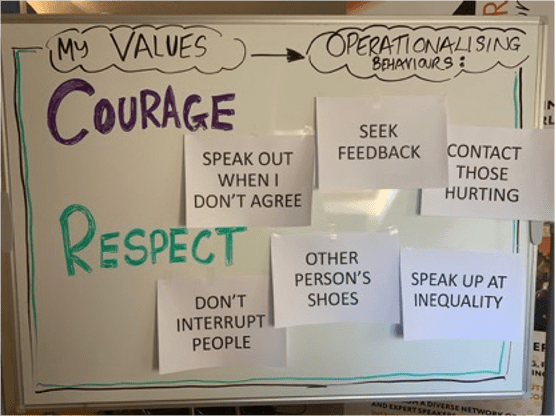
Brene’s research (I’ve attended a workshop she ran in New York so she’s on first name terms in my mind at least) shows that only 10% of organisations can say that they genuinely operationalise their values. These organisations have higher productivity, more engaged people & less staff turnover.
One of the fundamental side-effects of ‘doing what it says on the tin’ with consistency and authenticity, is trust. When I was a Commercial Director in the food sector I remember some pretty big ‘ding dongs’ with retailers. They were almost always to do with money; price increases, price queries, unsolicited deductions, failure to deliver or favouring a competitor; you know the sort of thing.
If my values had been firm and operationalised, I would have managed those situations very differently. I must have been growing into them though, as I am still connected to many of those adversaries; one actually gave me a job a year later, and I’ve scheduled to see his family later this year, COVID-willing.
What are your top two values and what do you need to do to operationalize them with your customers? If you’d like to do the exercise for yourself and your team get in touch with me and book a hugely reflective and valuable 2-hour virtual session.
HOW? – Skills & Behaviour
All good leaders know that sales teams are energised and motivated by skills development. A Salesforce survey last year found that 78% of sales people were fearful of approaching customers whilst they were home-working. We are proud to say that all of our clients have chosen to continue to energise and inspire their teams through virtual classrooms and blended learning. Some took a while to be convinced that it would work, some jumped straight in.
Most of our training, like the selling done by our client teams, was face-to-face up until March 2020. Uspire’s trainers were away coaching teams all over the world. Early March 2020 saw our diaries emptied, as one client after another took the wise decision to keep their teams safe. The same happened for our client’s sales teams. As Lockdown 1.0 kicked in, we were kicking our heels until we seized the chance to upskill ourselves and our global training partners.
In May, we were all awarded accreditation as ILM Virtual Trainers and something wonderful happened. We pivoted. We realized that salespeople and their leaders were struggling to connect with customers. The training that we had received was exactly what sales teams needed. We learned to Zoom, we raided Amazon for home flip charts, light rings, posters & pens. We created short, virtual sessions to replace classroom workshops, we taught teams how to be as impactful, and sometimes even more than F2F. We trained and retrained Colourful Connecting especially with customers under stress. Our more popular programmes now are How to Sell From Home and Presenting With Virtual Impact.
Here is our S.H.A.R.E Selling Model, you can read more here: Leading Sales From Home
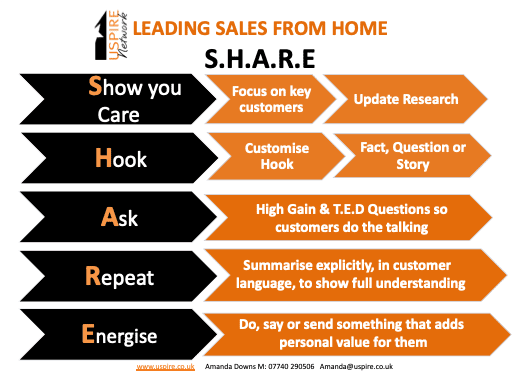
My next recommendation to you as a leader seeking to inspire your team is to use Colour Energy psychometrics. As a Commercial Director for United Biscuits Ireland, I returned to this awareness and influencing tool time and time again. We’d use the Team Colour Wheel as a ‘go to’ poster when preparing retailer pitches.
If you haven’t used this tool, then we are here to help Here are our most frequently used tips for sales teams to connect and flex with each other and customers.
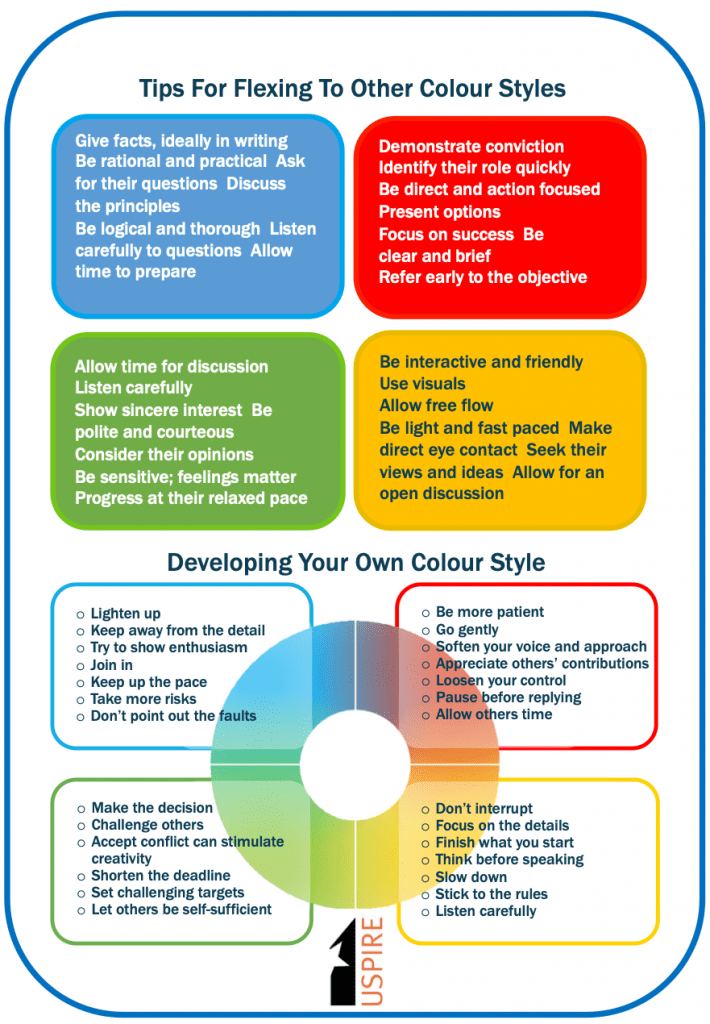
WHY BOTHER? – Motivating yourself & your team
Clarity of direction, alignment with the long-term vision and establishing greater competence are no match for this final point on the Performance Triangle. If you haven’t nailed the ‘why bother’? question you can forget the rest!
One of my best coaching assignments was a few years ago, with the sales director of a SAAS company in London. Ten minutes into the goal-setting stage of our first meeting I realized he didn’t want to be there. As I found out, he was lined up to be the next MD, with training, mentors, coaches, the lot. This 30-something talent really just wanted to take a year out, travel, jump off cliffs and learn to fly a drone camera. ” What’s stopping you?” said his coach. Six years later my coachee runs a successful SAAS business from Thailand having jumped, travelled, met, wed and become a father on the journey.
The Performance Triangle falls over without focus on Motivation.
Ask yourself and each team member “ Why do you do what you do?”
If we ask the right questions and listen with a curiosity to understand, we uncover what gets us and others out of bed.
It is a common misconception that it’s the job of the leader to motivate a team, or that salespeople are only driven by incentives. That’s not my experience at all. It is however, your job as a leader to encourage team members to understand and work on their own motivators.
At Uspire we use Colour Profiling to help individuals and teams understand their style preferences and how to flex to them to each customer style. Jungian-based psychometrics describe personality style which comes from past experience. Barring significant trauma, style is mostly fixed and exhibited in our daily, unconscious behaviour. Motivation however, comes from a view of the future and it often changes.
Motivational Mapping is one of the best tools I’ve seen, to create a common language and to encourage conversation around motivation. The Motivational Map assessment measures your motivation at a moment in time, because it changes, and boy, has motivation changed for teams this year! One of the most powerful tools for a leader is to see a ‘Team Motivational Map’ every year. It’s like a personal engagement survey.
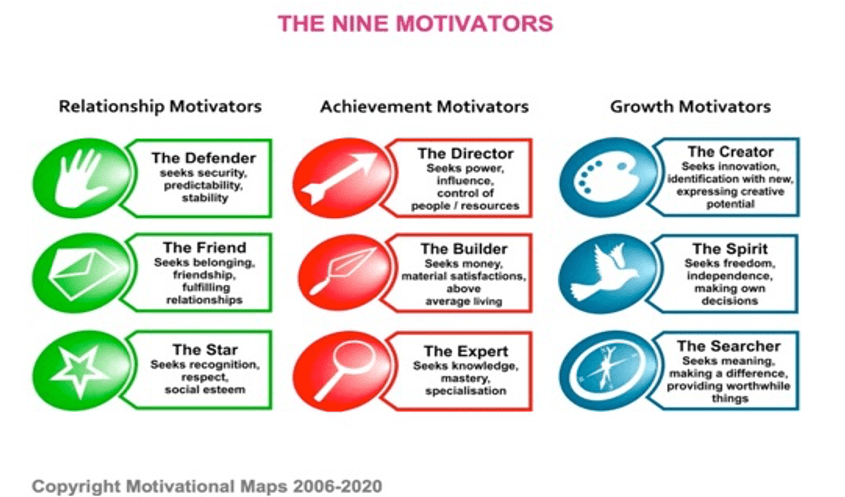
I have completed my own Motivational map every year for the last 5 years. Unlike my Colour profile which remains constant, my Nine Motivators have moved.
Understanding my own mix of motivational drivers has helped me to choose activities that energise me. As a member of our business development team, for example I know that I am energized by being involved in creating new products, as long as there is a deadline.
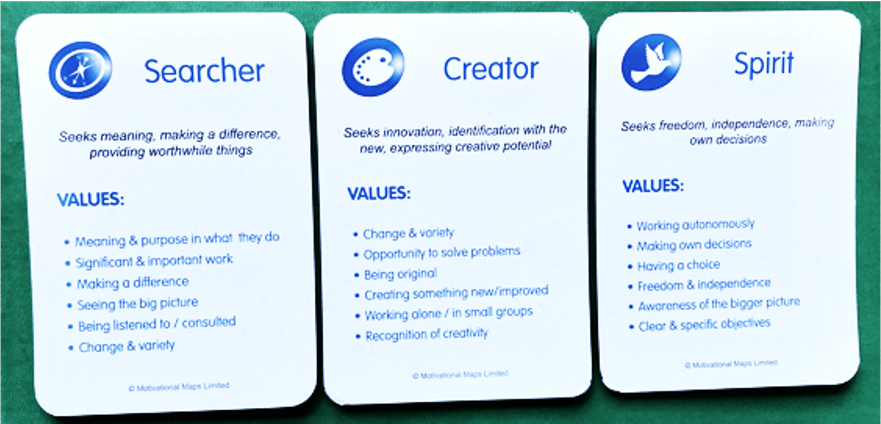
A Final Thought from Kate’s book Creating Motivation

If you and your team would value your own Motivational Maps, please get in touch.
Amanda is our Director of Commercial Leasdership at Uspire.
She is a keynote speaker, board facilitator and commercial leadership coach.
To get in touch email her direct amanda@theuspiregroup.com
Uspire are accredited practitioners in the following leadership & team development tools


